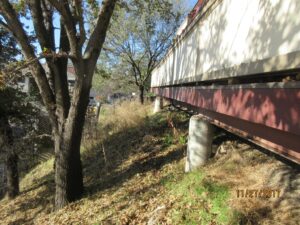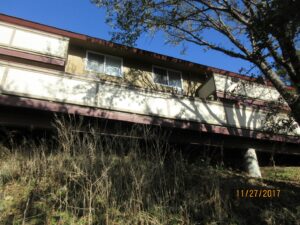In 2015, one of our property management clients purchased an apartment complex in Northern California that consisted of five, two-story buildings. One of the buildings in the complex (constructed in the early 1960’s) has had a long history of foundation problems, consisting of fill settlement and slope movement. This building movement had caused leaks in the below ground plumbing (water pipes and sewer pipes), which caused additional settlement and movement of the building.
Attempts to stabilize the building, and to lift it to approximately level, were made in the early 1980’s and in the mid-1990’s, approximately 15 years later. We were contacted about 20 years after the latest repairs because the building was again becoming seriously tilted and potentially unsafe (and certainly inconvenient) for occupancy.
By the time Helfrich-Associates was hired, the building was more than 4 inches out of level since the last time the building was lifted and leveled. Because of this movement, the drain lines had been leaking into the soils below the building for several years, causing further movement and instability.
Our repair recommendations consisted of underpinning the most affected parts of the building, which consisted of the interior walls that had settled due to the leaking drainpipes. These interior walls and footings were not underpinned in the 1980’s and 1990’s, when just the exterior walls were stabilized. This work was completed in 2016, but continuing slope and soil movement continued to cause cracks and separations in the building walls and ceilings.
Measurements of the building and soil movement were made once in 2017, three times in 2018, once in 2019, and once in 2020. Although the slope moved about one inch between 2017 and 2019, no significant movement occurred between January 2019 and June 2020. Based on our analyses, movement of the slope correlated well with rainfall (heavy rainfall caused more slope movement).
Our final report (sent to the client in June 2020) stated that no significant movement of the slope has occurred since January 2019. The building is safe to occupy, but is expected to continue to require above-average levels of cosmetic patching and painting of interior and exterior finishes. Small movement of the slope soils is expected to continue in response to rainfall and gravity.
Plumbing tests of the water supply lines and waste lines should be performed annually to verify that they are working properly, and all leaks should be repaired. Voids below the floor slabs of the ground floor units that have experienced movement should be filled with light weight grout to restore soil support to the slab.
No additional underpinning or strengthening of the building foundations is recommended at this time. The lesson here is that building on slopes can be problematic under the best of circumstances. According to multiple sources, Lafayette, CA, receives 24-inches of rainfall per year, the soils geology and the area prone to earthquake, which all complicate the issue.
For rental property owners in hillside locations in a similar situation, rainfall alone can be a foundation maintenance issue that requires annual inspections and attention, along with setting aside a larger than normal long-term planned maintenance expense account. Managing this type of maintenance issue requires the services a professional, licensed structural engineer to assure a thorough analysis to protect the property and the ownership’s investment.


